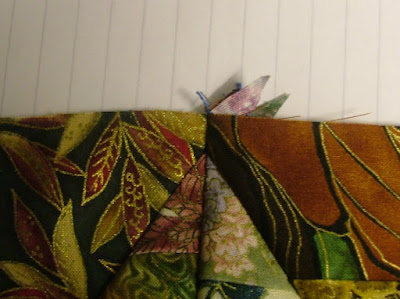CREATING THE BLOCK
It is better to build up a few light and dark panels before
attempting to join them together. This allows your range of fabrics to spread
throughout the quilt giving a ‘random’ appearance which is vitally important
for a scrap quilt.
1 The main reason for sewing onto paper is to create an
accurate block every time so before the paper is removed, the blocks need to be
trimmed to the edge of the paper with rotary cutter and ruler.
Trim the panels
Remove the paper
Cut on one of the diagonals
Cut on the other diagonal
Cut 1 dark and 1 light
8 triangles create a diamond
6 Place two triangles RS together, so that the raw edges of
the diagonal seams are level. Rather than put the two points exactly together,
allow the sharpest point to extend a good ¼” beyond the gentler point. Sew an
accurate ¼” seam.
7 Sew the four diagonals to each create a rectangle that is
one quarter of the design and place them back into sequence. Do not press at
this stage.
Sew the 4 diagonals
Repeat this process for the lower half of the diamond to
complete the block.
9 After checking the direction of the diagonal seams butt
the seams together and sew across the middle horizontal seam to complete the
diamond.
And these are the building blocks for a diamond string
quilt.














No comments:
Post a Comment